5 Things NOT to Buy When Starting Baby-Led Weaning
- MESH TEETHER BAGS - also called feeding bags, these are not only unnecessary but they can actually be dangerous when feeding babies. Inside the episode, I'm sharing a personal story with a mesh teether that will make you think twice if you're considering using these for starting solids with your baby.
- BABY FOOD MAKERS - if you have a pot with a lid and a source of potable water, you essentially can do what the fanciest top-of-the-line baby food maker does: steams the food. Then if you have a fork, you can mash that steamed food. So save your money and some counter space and bypass the baby-food maker.
- LONG HANDLED SPOON - most baby spoons are designed for parents to spoon-feed a baby. I'm sharing my favorite alternative, a baby-led weaning spoon that was designed with your baby's feeding milestones and self-feeding abilities and has a short, fat, round handle.
- HIGH CHAIRS WITHOUT FOOTRESTS - having your baby's feet resting flat on a solid surface is imperative for facilitating a safe swallow. I'm sharing 2 high chairs with adjustable footrests that I use and recommend as well as some ideas for DIY hacks to make your current unsafe high chair safer and adding an “after-market” footrest.
- BABY-SPECIFIC FOODS - whether it's baby oatmeal or baby yogurt, the reality is you do not need to buy baby-specific foods. Your baby can safely eat modified versions of “adult” foods and I'm sharing a few tips for making this happen so you can bypass the entire baby food aisle!
- HIGH CHAIRS mentioned in this episode:
- SPOONS mentioned in this episode:
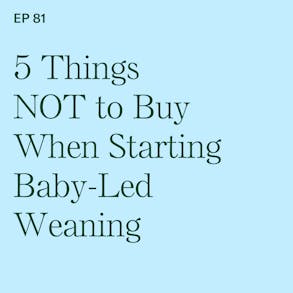
LISTEN TO THIS EPISODE
Episode Description
You do not need to buy a bunch of STUFF to give your baby a safe start to solid foods! There are so many items and gadgets and doo-dads for sale, it can be confusing to try to figure out what you actually need!
In this episode we’re going to narrow it down to what you actually might need for starting solids by going through a list of things you definitely do NOT need. Baby feeding gear can get downright gimmicky, and some of the stuff you see for sale can actually even be harmful.
If you’re just getting started with solid foods and baby-led weaning, here's a quick rundown of 5 things you do NOT need to buy to get a safe start to solid foods!
Links from this Episode
HIGH CHAIRS mentioned in this episode:
- Stokke Tripp Trapp high chair
- Nomi high chair
- SPOONS mentioned in this episode: ezpz Tiny Spoons designed by BLW feeding expert
- Baby-Led Weaning with Katie Ferraro program with the 100 First Foods™ Daily Meal Plan, join here: https://babyledweaning.co/program
- Baby-Led Weaning for Beginners free online workshop with 100 First Foods™ list to all attendees, register here: https://babyledweaning.co/baby-led-weaning-for-beginners

Latest Episodes
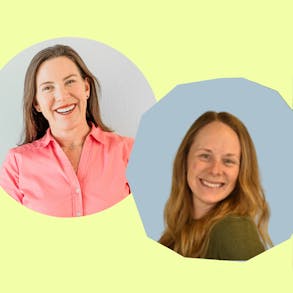
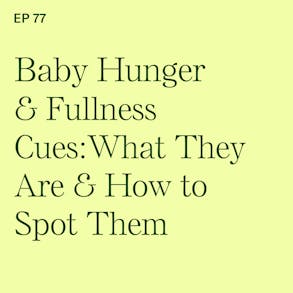
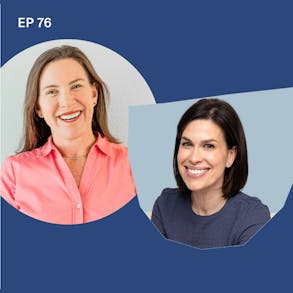
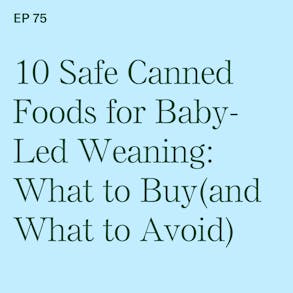
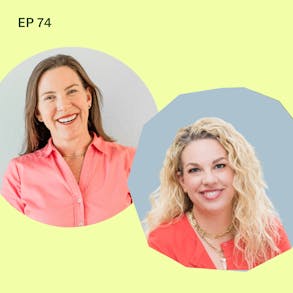
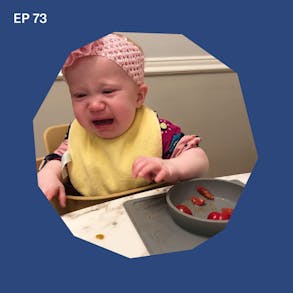
Katie Ferraro (1s):
And there are just so many products out there marketed to parents that prey on our fears when we're doing something new and scary, like starting solid foods, not only are a lot of these products completely unnecessary, but they can actually be dangerous. So here's what you need to avoid. Hey, there I'm Katie Ferraro, registered dietitian, college nutrition professor and mom of seven specializing in baby led weaning here on the Baby Led Weaning Made Easy podcast. I help you strip out all of the noise and nonsense about feeding, feeding me with the competence and knowledge. You need to give your baby a safe start to solid foods using baby led weaning.
Katie Ferraro (42s):
Welcome back. It's another episode of the baby led weaning made easy podcast. And I don't know about you guys, but I'm a little overwhelmed by all of like the gift giving gift, receiving gift guides, stuff out there right now, we are heading at the time of this recording into the holiday season and we're in the thick of the gift stuff. So in this episode, I'm going to go in a little different direction and I want to run you through some ideas of things you do not need to buy when you're starting solid foods. That's right. We're going to do five things not to buy. When you begin, baby led weaning. Now I'm a big fan of not needing to buy very much stuff or gear in order to give your baby a safe start to solid foods.
Katie Ferraro (1m 27s):
There are so many gimmicky products out there that if you're feeling overwhelmed, I just want to let you know it's okay. If you don't have one of these, I hope that this quick list will help clear your mind. Now, I like to start out. Each of these baby led weaning mini training episodes with a baby led weaning tip of the day. And today's tip is kiss. Keep it simple, sweetheart. Don't go cruising the aisles at Target, looking for things to buy, just because your baby is about to move to a new stage when you start solid foods. I think before you start solid foods, the most important thing that you need is a safe highchair. And when I say a safe high chair, I mean one that has an adjustable foot rest that your baby's feet can rest flat on.
Katie Ferraro (2m 9s):
And that's even from his or her first bites, because not one of those dangling foot rests. You see them on some highchairs where it's really only good when the kid is a full blown toddler. I mean an adjustable foot rest that your baby's feet can rest on starting at six months of age, when you start solid foods. Now having your baby's feet resting flat on that solid surface helps support your baby's core and facilitates a safe swallow. And now you can certainly DIY and existing highchair to get there. You don't have to go and buy something fancy, but you do need a safe seat for your baby to Eaton. And if you are in the market for a safe seat, I've got a few recommendations for you in my family, feeding gift guide. I'm going to link that up for you on the show notes for this episode, which you can find at blwpodcast.com/81.
Katie Ferraro (2m 55s):
So we're going to talk today about things not to buy, but if you're looking for some things you might consider picking up or might make your life easier, the family feeding gift guide has a high chair section, both traditional high chairs. There's two that I personally use both for my family and in my infant feeding practice, as well as my favorite portable highchair. So again, go to BLWpodcast.com/81 for those highchairs. Now, before I get into the five things not to buy when starting solid foods, I know some of you guys are trying to guess the five things on the list. And if you listen to the podcast and you follow any of my courses in classes, I bet you're like I can read her mind. And I'm going to guess the five things on the list. And I bet some of you are thinking pouches, but I want you to know, pouches are not on the do not buy list.
Katie Ferraro (3m 40s):
I want you to hang tight because of this episode, I'll be sharing why pouches are perfectly fine, but only if you utilize them using a particular technique that will help promote independent feeding. So let's get started. Let's look at the five things you do not need to buy when you're starting baby led weaning. Now I want to start this episode with a caveat that if you have any of these things, they're not bad. I'm just saying for parents who are like, oh my gosh, I'm super overwhelmed with all this stuff. That's out there. Because my baby's moving into this new stage. I want you to know that you could definitely live without these things diving right? In the first order of business. I want to talk about number one on the list are mesh teethers. You do not need a mesh teether again. If you have one they're not bad, but let's talk for a second about meshed healers.
Katie Ferraro (4m 23s):
If you're not familiar with the concept of a mesh tea that it's also called a mesh feeder or a feeder bag or a teether bag, it's this little plastic ring that has a mesh bag attached to it. And you insert a food in there. And then the baby sucks the food through the mesh bag. And they're designed for parents like many baby things to give the perception of safety parents like, oh my gosh, I'm scared about gagging and choking. If I put this food in a bag, then the baby can just suck it out and they'll eat it safely. And they won't choke. Here's the problem with the mesh teethers babies need to experience and explore a variety of different textures. So we want to offer safe shapes and sizes and textures of foods that babies can eat.
Katie Ferraro (5m 6s):
And there's no food that you would put in a mesh teaser bag that I can't show you how to make safely and serve it outside of the teether bag. There's no data or evidence whatsoever that supports this notion that a product like that helps reduce choking. And in fact, a mesh teether bag can actually be dangerous. I know my own sister-in-law with her. Oldest is one week younger than my oldest. When they started solid foods, her daughter already had one little tooth coming through. She put a piece of fruit, a watermelon, which yes, it is a fruit that can be challenging for some babies to eat, but they can certainly eat watermelon safely. She put it in the bag. The baby was sucking on the watermelon, through the bag, hold the teether bag out of her own mouth and popped her own little baby tooth out.
Katie Ferraro (5m 51s):
Now my sister-in-law's defense, it said all over the packaging. Don't give this product to a baby, that has teeth, but what do you do when you get a mesh Teeter bag? You throw the packaging out. And lots of people feed these to babies that have teeth extracted her own baby tooth. It's funny. because the girls, our daughters are six years old now and it's like totally fine for six year olds to be missing their front teeth. But my poor niece has been missing. I think her front tooth since she was six months old due solely to a teether bag. So again, they can, in some cases actually be dangerous, but they're completely unnecessary. They give a false sense of security. I would much rather see your baby and you learn how to prepare foods safely and offer them to baby safely. Some parents say, oh, I like them for offering frozen items.
Katie Ferraro (6m 32s):
You can freeze. For example, whole milk, full fat yogurt in a little ice cube tray and feed it to your baby. They can eat it with them hands. They can eat on a spoon. You could do it in a bag if you want to, but please no baby even has one tooth. That product is completely inappropriate. All right. Number two thing that you don't need to buy for baby led weaning up baby food maker, baby food makers. To me. I don't get it. I mean, I get it, but like I have a pot with a lid and I have water. So I essentially have the tools that accomplish the same exact thing that a baby food maker does. I was dying a baby food maker company approached me one time to do a collaboration. And I was like, oh, I'm sorry. I just really can't justify the price of a product that essentially steams food with water.
Katie Ferraro (7m 17s):
Like I'm all for it. Products that make your life easier. Like when I was feeding my quadruplets, I actually had the formula maker machine because we were making so many bottles and it made it perfectly at the right consistency. And if you would ask me like with one kid who would buy a formula maker, I was like, nobody it's a formula maker, but in that particular phase of my life, the formula. So maybe if you don't have a pot with a lid and don't have water, then a baby food maker would make sense. But to be honest, a baby food maker just steams food, which you could do with a pot and water. You could also do it in a microwave. So you don't need a baby food maker. Next item that you don't need to buy when you're starting baby led weaning, but you might be inclined to is a long handled baby spoon. And my good friend colleague, Dawn Winkelman, she's a speech language pathologist and the feeding expert for EzPz the company that makes a lot of the feeding gear that I use both in my family and in my practice.
Katie Ferraro (8m 6s):
She always makes the point that the majority of baby spoons on the market are designed for parents, right? They're designed for parents to hold, put food on the spoon and then put the spoon in the baby's mouth. They're not designed for babies to self feed. Any spoon with a long handle is for parents to put the spoon in the baby's mouth. And if you're doing baby led weaning, the whole premise of baby led weaning is that the baby drives the eating process. Now we'll talk a little bit about spoons in a second, but Dawn also known as Ms. Dawn SLP. She did develop the tiny spoon for EzPz, which is radically different looking the short fat round handle that babies can use. You might have to help them preload the spoon, but they're ultimately the ones doing the feeding.
Katie Ferraro (8m 49s):
So if you're going to be doing baby led, weaning, just get rid of all the long-handled spoons. They're very cumbersome for your baby. Who's trying to learn the mechanics of dipping and then scooping. I highly recommend the tiny spoon that Dawn designed. You can check it out at EzPzfun.com. And if you use the code, Katie 10, you can get 10% off all of the easy-peasy products. Now the fourth item on the list, and I teased this a little bit at the top. You do not need to have a high chair in your feeding area. If it doesn't have an adjustable foot rest. Now, if you buying a new high chair, go check out some of the ones that I recommend on the family feeding gift guide. That's at BLWpodcasts.com/lash 81, but you already have high chairs, but some people get offended at this recommendation.
Katie Ferraro (9m 32s):
Like got a high chair. I got it from my baby shower and I'm going to use it. Okay. If you haven't opened it yet and you do a little online and you realize, oh, it doesn't have an adjustable foot rest. If they're still the opportunity to return it. A lot of people end up doing that when they start educating themselves about the safest way to feed their baby. A lot of the highchairs out there have very long foot rests that only work when babies are like two and three years old. There's a lot of DIY hacks that you can do. If your chair doesn't have a foot rest. So for those of you that have the Ikea antelope high chair, I love the adjustable foot rest that the company Yeah Baby Goods. Y E A H baby goods makes basically an aftermarket foot rest that goes on that Ikea antelope feature, the analytics like one of the most ubiquitous highchairs, cause it cost $20.
Katie Ferraro (10m 18s):
The footrest ironically costs $30, but the point is for $50 or $30 rather you've just made the $20 highchair, a safe place to eat. $20 high chair on its own is not, we don't want babies to have dangling likes. Another thing you can do with your existing is take an adult chair and turn it around so that the seat side goes underneath the baby's feet and then stack it with boxes or books at my mom's house. She saves all the phone books. So we can use that. Because she's got some really, really bad old high chairs, but we can make it adjustments to them to make them safe for a baby to eat. So number five on the list of things you do not need to buy. When you start baby led, weaning include baby specific foods. Now, when I'm talking about baby foods, you guys know with baby led weaning ultimate premise is that babies will be eating modified versions of the same foods, the rest of the family eats.
Katie Ferraro (11m 6s):
But if you go to Target and I'm not dissing Target, I just mentioned it because there's an intense, I are aisle full of foods there that babies do not need to eat. And parents will see things like a little star puffs, which are a little starch balls, which have no nutrition in them. You're basically paying for air in a canister. They're so small that first before the baby has the pincer grasp, they can't even pick those little puffs up with their whole hand grasp. So they don't promote independent feeding because babies don't get their pincer grasp until a few months into eating foods. Not to mention that those little puffs with that starch that they're made from when it combines with the baby saliva, they can actually ball up and become exactly the size that would get stuck in a baby's throat, occlude the airway and caused them to choke.
Katie Ferraro (11m 49s):
And parents are like, what? It's a baby food. It says it's a first stage food. There are lots of different types of first stage foods that your baby can eat. That are real foods. You're essentially paying $5 for a packet of air that could actually be harmful your baby. So just be aware that a lot of the baby food products that are marketed to parents are actually not appropriate for babies. And the perfect example is baby yogurt, read the ingredient list on any baby yogurt in the store. And you will see an added sugar added sugars are not appropriate for babies. Under two period, you can feed your baby whole milk, full fat, plain yogurt. You don't need to go buy baby yogurt, which not only costs more per ounce, but also has added sugars, which again, we don't feed to babies.
Katie Ferraro (12m 32s):
Parents are like, what? But it says baby yogurt on it. The one that kills me is the shelf stable yogurt in the baby food. I'll have you guys seen this, go to target, go to your grocery store. There's a yogurt. I don't wanna mention the brand, but it's on the shelf. If it's on the shelf and not refrigerated, do you guys think there's actually yogurt in there? No, not to mention there's added sugar. So again, you don't need to buy baby specific foods. You can modify all of the regular foods that the rest of your family eats and some families like, oh, I want the convenience. Okay. But you need to analyze what's in that convenience food. If it's the size that when combined with saliva could potentially choke your baby, or if it has added sugars, which is not appropriate for your baby, we need to weigh convenience against nutrition and safety.
Katie Ferraro (13m 16s):
Another example is baby oatmeal. Sometimes parents like, well, I'll just, I need to buy the special kind of oatmeal. If you compare the cost of baby oatmeal to regular oatmeal, it's ludicrous, you can make babies oatmeal out of regular oatmeal. And if you guys want more information and tips and tricks about making regular oatmeal for babies, I've got a podcast. Episode is episode number 47 as called oatmeal. How your baby can safely self feed oatmeal. Some parents will say, oh, well, there's more iron in the baby oatmeal. Well, regular oatmeal is a whole grain and there's iron in there as well. I encourage parents to start offering their babies of variety of foods that contain all sorts of different nutrients, including iron, but natural versions of it.
Katie Ferraro (13m 60s):
Because once your baby hits one and you don't feed them, quote, unquote, baby foods, and they're not getting iron from their formula, they don't magically wake up knowing how to eat meat and whole grains and other nutrient rich foods. So don't get in the habit of relying on baby foods. If you're starting solid foods, your baby has the opportunity to like and try and accept a huge variety of foods and flavors and tastes and textures. So I hope you guys enjoyed a quick little run through of some ideas of five different things that you do not need to buy. When you begin baby led weaning. It was hard for me. You have to be honest to limit it to five, just because I think so much of the gear out there is so gimmicky. But I reached out to guys social media and was asking, like to share some ideas of things that you bought or got that you now realize, like related to feeding you totally don't need one follower.
Katie Ferraro (14m 49s):
Kelly, Amanda wrote back to one of my emails that she said, okay, some of the things I have not needed so far, like I have a lot of plates that don't suction. So they like slide all over the place and it just frustrates everyone and makes a bigger mess. She mentioned mesh feeder bags as being something she doesn't need weird utensils that don't look like adult utensils. And then also traditional bibs that like snapper tie behind the baby's neck. Cause if you think about it, like those get pretty tight sometimes. And if you're trying to learn how to eat or even eat, when you, you know how to in something is like basically choking you around the neck, that can be a pretty negative sensory experience. So I prefer the bibs that tie underneath the back of the baby's shoulder, your blade, there's a brand I like called BapronBaby. They make this hybrid. It's like a bib, but an apron perfect for baby led weaning.
Katie Ferraro (15m 31s):
If you go to BapronBaby.com, the code Katie 10 works for 10% off there. And you can check out those bibs that then don't kind of choke off your baby around the neck. Now I just want to read if you have any of these things that we talked about, there's nothing inherently bad about them. In some cases they can be dangerous, but just keep in mind if you're feeling overwhelmed by all the stuff out there that a lot of the products that are market to us as parents, especially when we're learning to do something that is new or a little scary, like starting solid foods. They're really just there to prey on our fears and they end up being totally unnecessary. I do think there are a few pieces of gear that can make your life easier when you're starting solid foods. In some cases like the item, like a high chair, I know it's a big ticket item.
Katie Ferraro (16m 13s):
It is an investment, but you do have to think, gosh, this is something I'm going to feed my child in for at least three times a day. Some of these chairs extend well into adolescents, certainly worth the money investing early on versus wasting our money on a bunch of other gimmicky stuff out there that will or need. So if you want to check out some of the picks that I have selected, that I really do like and use again, both of my family, I lined them all up for you guys in a family feeding gift guide. There's a high chair section. You want to check out. You can find that at blwpodcasts.com/81. And just to finish off episode, remember I mentioned, pouches are not list now pouches, which contain pureed foods.
Katie Ferraro (16m 55s):
Babies don't need to learn how to suck it. Them. The thing I don't like about pouches is that there's no developmental milestone or feeding goal that we have to teach our babies today. Out of a foil to pat purees are fine, provided that you're alive your baby to feed the purees. And how do you do that? If you have a pouch, you can squeeze the pouch and doable. You can scoop the food from the bowl onto the spoon, hand the spoon to your baby handle side first and allow the baby to bring the spoon to their mouth. Now, pouches end up getting really expensive. I was laughing. It was at Target. I've seen a lot of Target references today that is not in any way sponsored by Target, but was that Target. And there's a particular brand of refrigerated pouch food. And it was $5 a pouch. And I was like, if parents buy three of these a day, which by the way, not even nearly enough food, when your baby gets going with eating solid foods to meet the nutrition needs, that's $15 a day.
Katie Ferraro (17m 41s):
Like I don't even spend $15 a day to feed my 7 kids. I feel like so pouches can get really expensive. They're not developmentally necessary. I prefer to babies. If it's a puree, which has an important texture for babies to learn how to master, we do periods, but I prefer foods that naturally need to be pureed like, or are pureed like oatmeal and unsweetened applesauce and yogurt. Those are great for doing baby led weaning, but you don't need to unnecessarily puree foods that babies can eat soft, solid versions of after the first few days of baby led weaning. So if you want to learn more about my purees for a few days, approach to starting solid foods, go check out episode five of the podcast.
Katie Ferraro (18m 23s):
It's how to do purees for a few days when starting solid foods, but you never need your baby to suck out of that pouch. All right. See you guys later. Bye now.
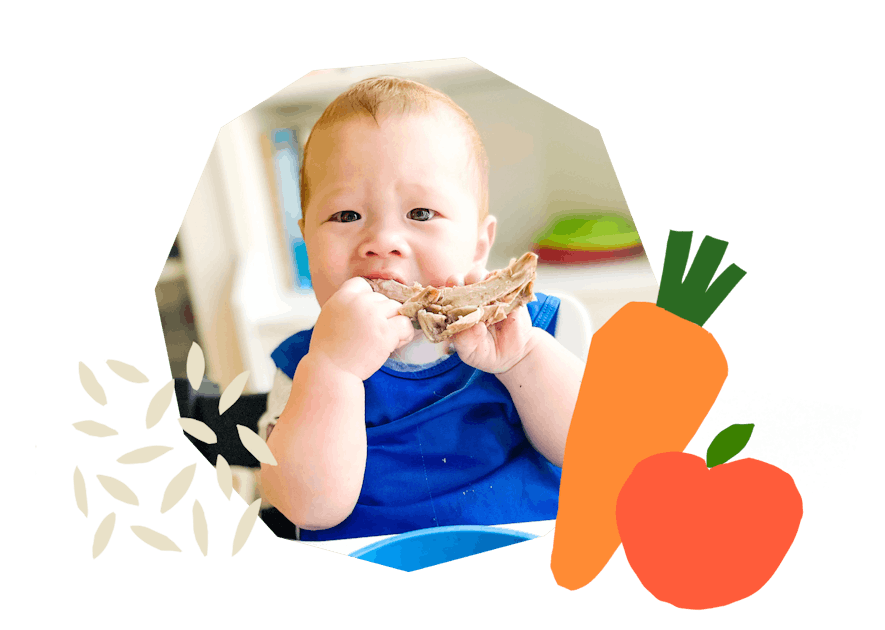
The Program Baby-Led Weaning with Katie Ferraro
A step-by-step digital program for starting solid foods safely and navigating the original 100 FIRST FOODS™ meal plan with baby-led weaning.
 EXPERT-LED, PROVEN APPROACH TO EATING REAL FOOD
EXPERT-LED, PROVEN APPROACH TO EATING REAL FOOD CONCISE VIDEO TRAININGS TO MASTER BABY-LED WEANING
CONCISE VIDEO TRAININGS TO MASTER BABY-LED WEANING 100 FIRST FOODS DAILY MEAL PLAN WITH FOOD PREP VIDEOS
100 FIRST FOODS DAILY MEAL PLAN WITH FOOD PREP VIDEOS
Baby-Led Weaning for Beginners Free Workshop
Is your baby ready to start solid foods, but you’re not sure where to start? Get ready to give your baby a solid foundation to a lifetime of loving real food…even if you’re feeling overwhelmed or confused about this next stage of infant feeding.
Get baby-led weaning recipes and tips delivered to your email inbox.

